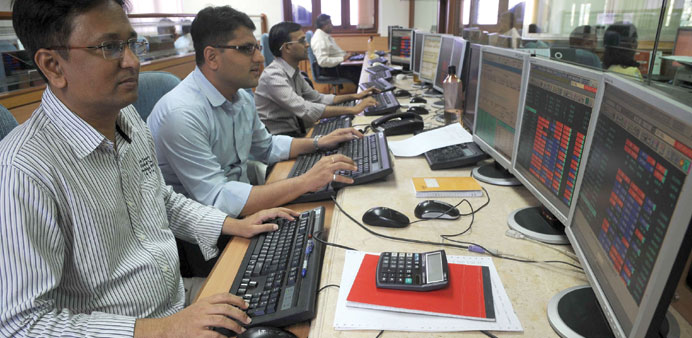Traders at the Bombay Stock Exchange. International investors have ploughed $705mn into India since June 12, sparking a world-beating 7% gain in the Sensex.
Bloomberg
Mumbai
The tumult in China’s stock markets has turned into a blessing for Indian shareholders.
International investors are pulling out of China, fuelling record outflows through the Shanghai-Hong Kong exchange link, amid a $2.8tn plunge in mainland equity values since June 12. They’ve ploughed $705mn into India over the same period, sparking a world-beating 7% gain in the benchmark S&P BSE Sensex index.
China’s interventionist response to the rout – including unprecedented trading restrictions – has prompted foreigners to shift their equity exposure to India, according to hedge fund Alexander Alternative Capital. The $2tn economy, which got a fresh boost from tumbling crude prices this month, is less exposed than its emerging-market peers to slowing growth in China, Aquarius Investment Advisors Pte says.
“The recent travails in China make India seem like an oasis of calm in terms of volatility,” Jonathan Schiessl, the head of equities at the UK-based Ashburton Investments, which oversees $12bn, said in an e-mail. The fund has cut its exposure to China by 1% in the past month to invest in Indian equities and raise its cash position, he said.
Gains in Indian shares over the past six weeks mark a turnaround from the preceding four months, when China’s bull market and doubts over Prime Minister Narendra Modi’s economic policies kept foreigners away. The Sensex tumbled 11% from this year’s peak on January 29 through June 12, making it the world’s worst performer after Egypt.
Those concerns have been allayed by the biggest jump in indirect tax receipts in May since 2011, which gives Modi ammunition to boost expenditure. A 12% decline in Brent crude prices this month has also pared government subsidy bills in a country that imports about three-quarters of its oil.
India’s economy expanded 7.5% in the March quarter, beating China’s 7% growth, while the International Monetary Fund predicts India will outpace its neighbour in the current fiscal year.
The longer-term growth outlook is also stronger in India because of its superior demographics, according to Franklin Templeton Templeton Investments. More than 62% of the nation’s 1.2bn people are between age 15 and 59, government data show. China’s pool of workers in this age group is expected to shrink by 61mn by 2030, according to UN. That’s about the equivalent of losing the combined working populations of the UK and France.
“India is in a phase in which multiple engines of growth can drive GDP from 7-8% to 9-10% in the next five years,” said Sukumar Rajah, who manages about $9bn as chief investment officer of Asian Equity at Franklin Templeton in Singapore. “For China, we expect growth to decelerate over the next few years partly because it doesn’t benefit from demographic trends the way that India does.”
Templeton is overweight India and underweight Chinese shares in Hong Kong relative to benchmark indexes, Rajah said. He’s bullish on Indian industrial companies such Larsen & Toubro Ltd amid signs of increased spending on infrastructure.
The Hang Seng China Enterprises Index declined 0.8% at 1:19 pm in Hong Kong on Friday after a private gauge of Chinese manufacturing unexpectedly fell to the lowest level in 15 months. India’s Sensex lost 0.3% in Mumbai trading, poised for a weekly decline.
For overseas money managers, China’s meddling has raised concern about the government’s promise to enact the free-market reforms needed to make mainland shares eligible for MSCI Inc’s benchmark indexes. Measures to end the rout include a ban on selling by major shareholders, halting initial public offerings and allowing more than 1,400 companies to suspend trading.
“The intervention puts a wet blanket on China’s indices being included in the MSCI gauges,” said Michael Corcelli, chief investment officer of Alexander Alternative in Miami. The steps “are bad for China and definitely good for India,” he said.
India’s stocks rally may unravel if the strengthening El Nino weather pattern weakens monsoon rains, said Anil Ahuja, the Singapore-based chief executive officer of hedge fund IPEplus Advisors.
The June-September rainfall, which was 16% above a 50-year average at the end of last month, is now 7% below normal, according to the weather office. The monsoon waters more than half of India’s farmland and a shortfall can stoke food prices.
The Sensex gauge trades at 15.9 times 12-month projected profits, compared with a five-year mean of 14.4, data compiled by Bloomberg show. The Hang Seng China Enterprises is valued at 8 times.
“A weak monsoon has not been priced in,” Ahuja said. “Valuation multiples are high versus long-term averages. If earnings don’t begin to justify valuations soon, investors will start to move away.” Indian earnings are projected to grow about seven times faster than China over the next 12 months. Profits at Sensex companies will climb 30%, versus 4.3% for the Hang Seng China Enterprises Index, analyst estimates compiled by Bloomberg show.
“India’s recent outperformance could be because it has a steady macro-economic picture and is relatively insulated from any slowdown in China compared with other emerging markets such as South Korea and Brazil,” said AS Thiyaga Rajan, a Singapore-based senior managing director at Aquarius. “India could see greater interest, now that it is projected to be the fastest-growing major economy.”

